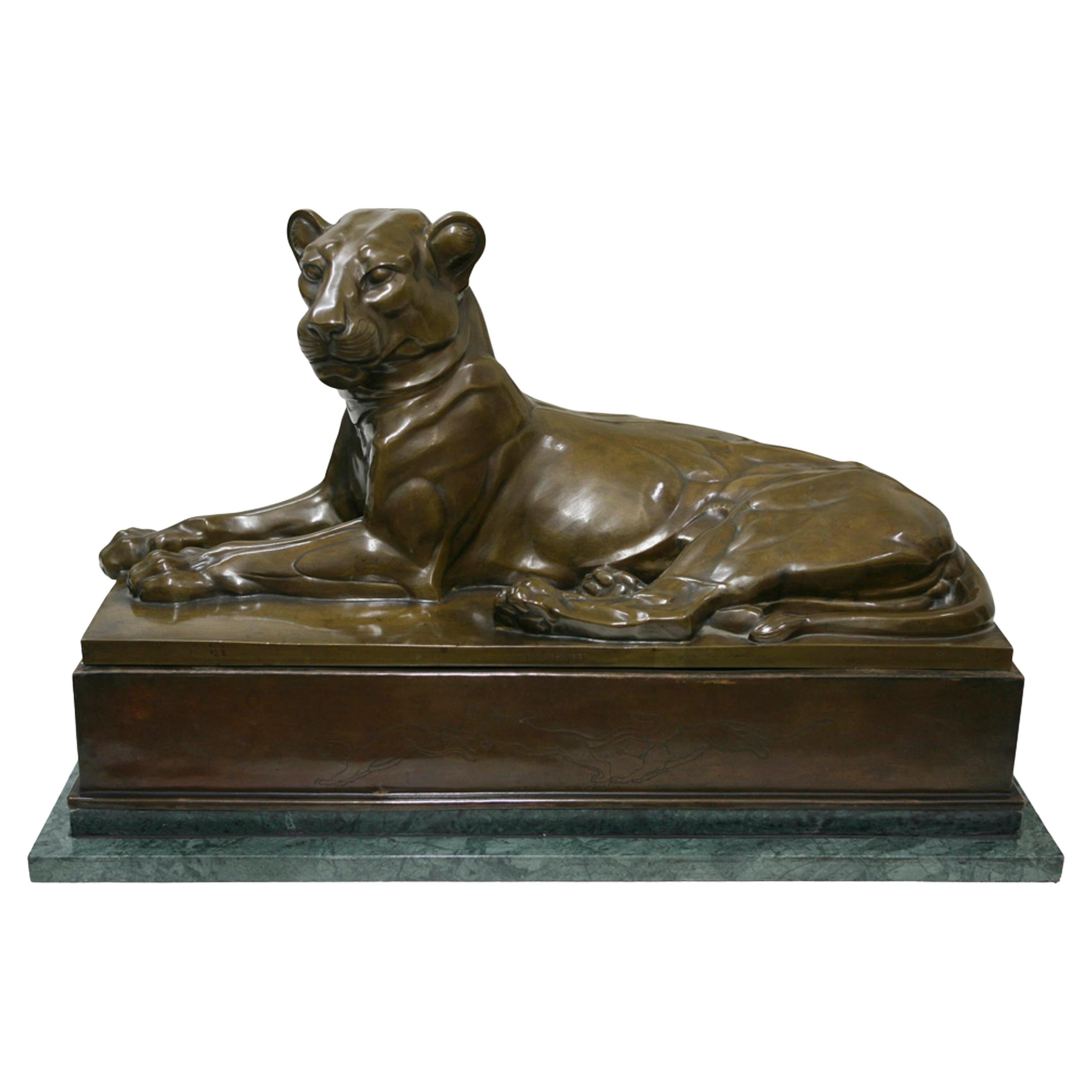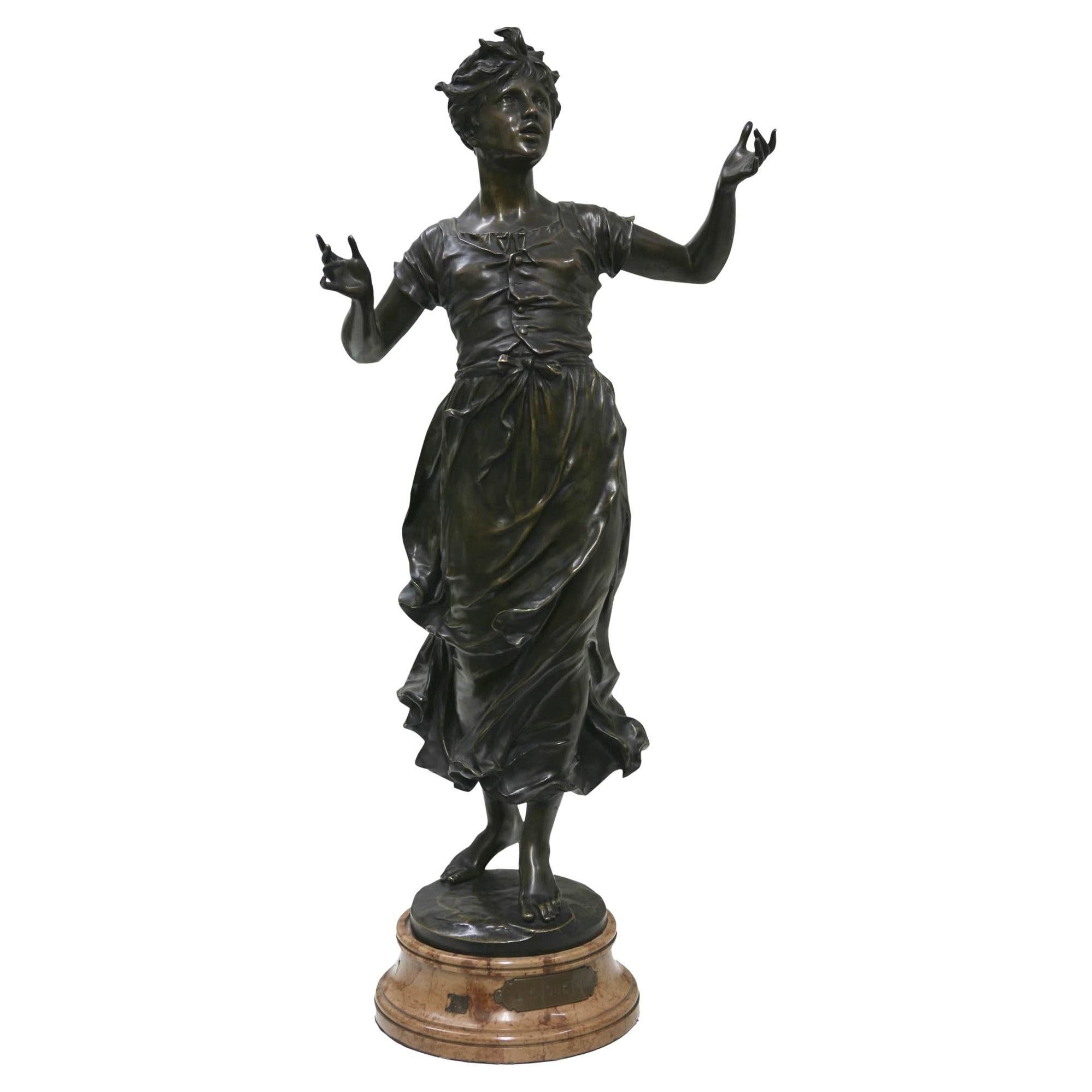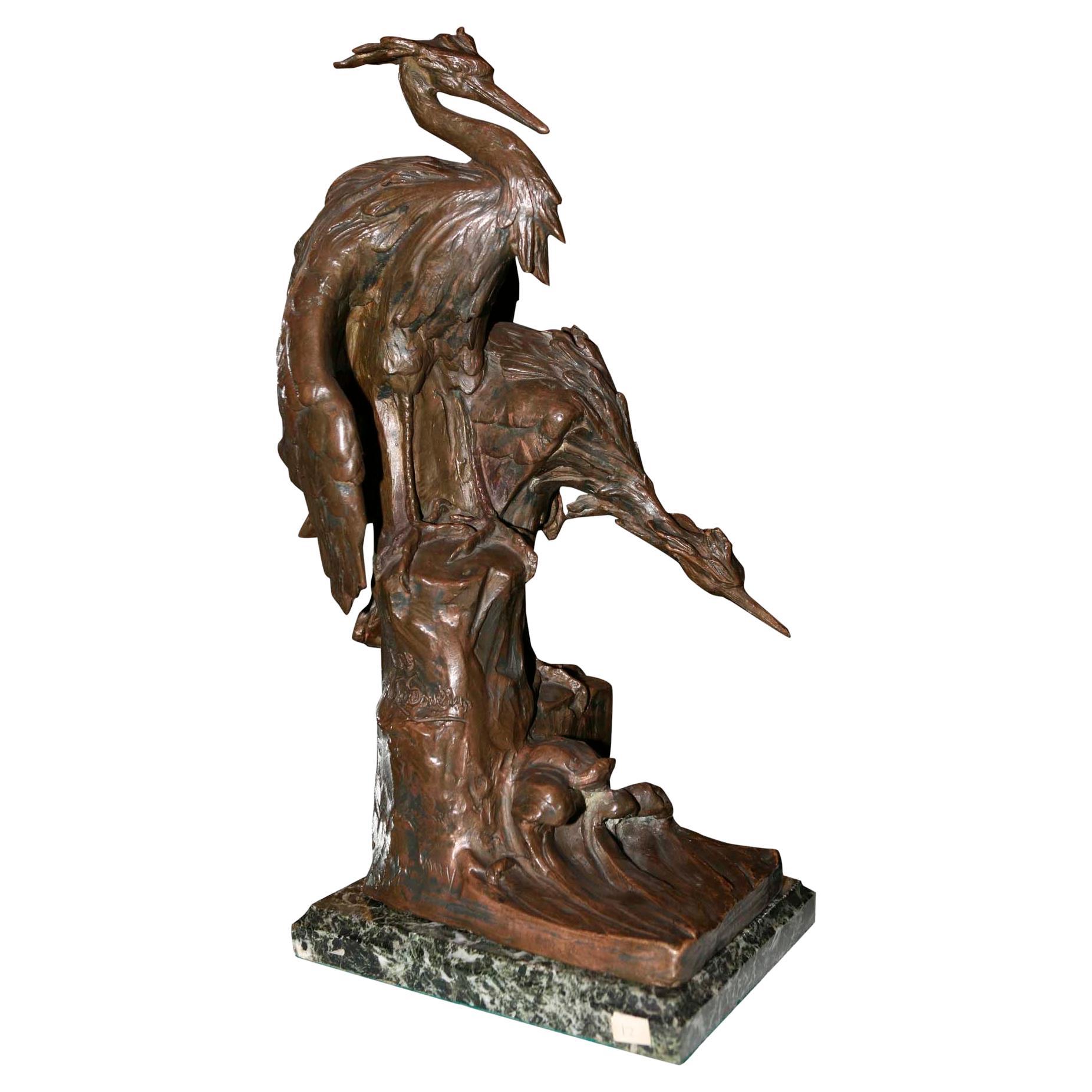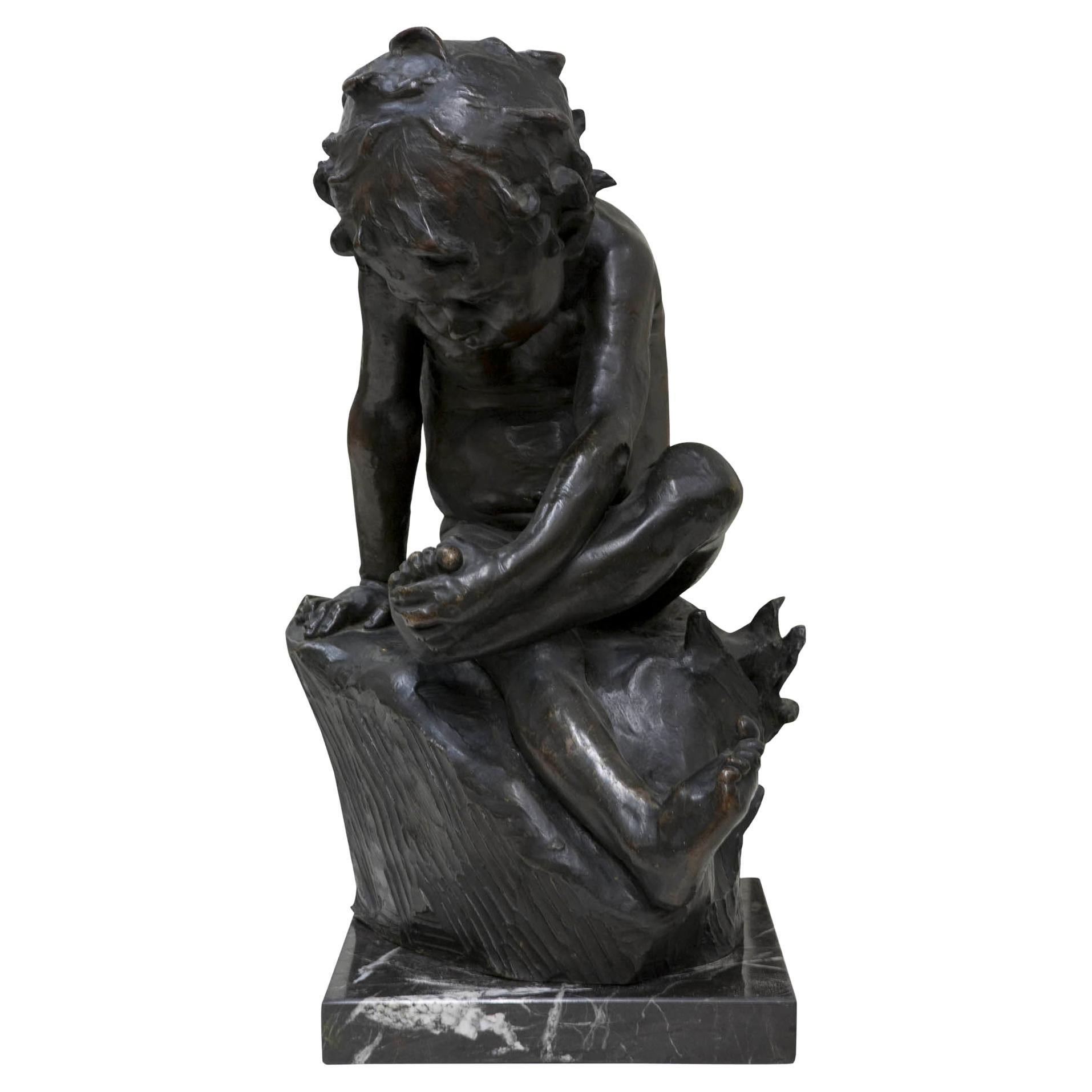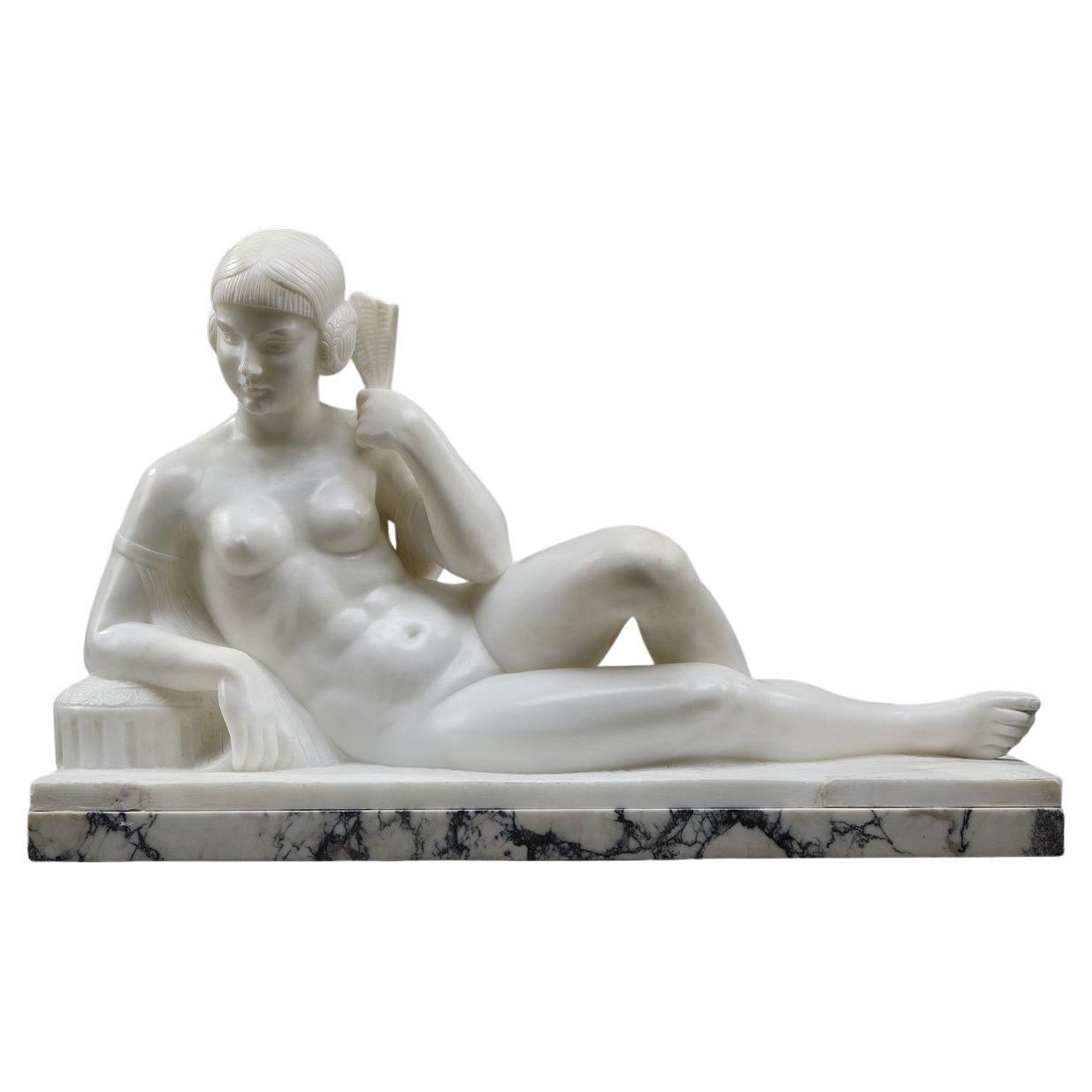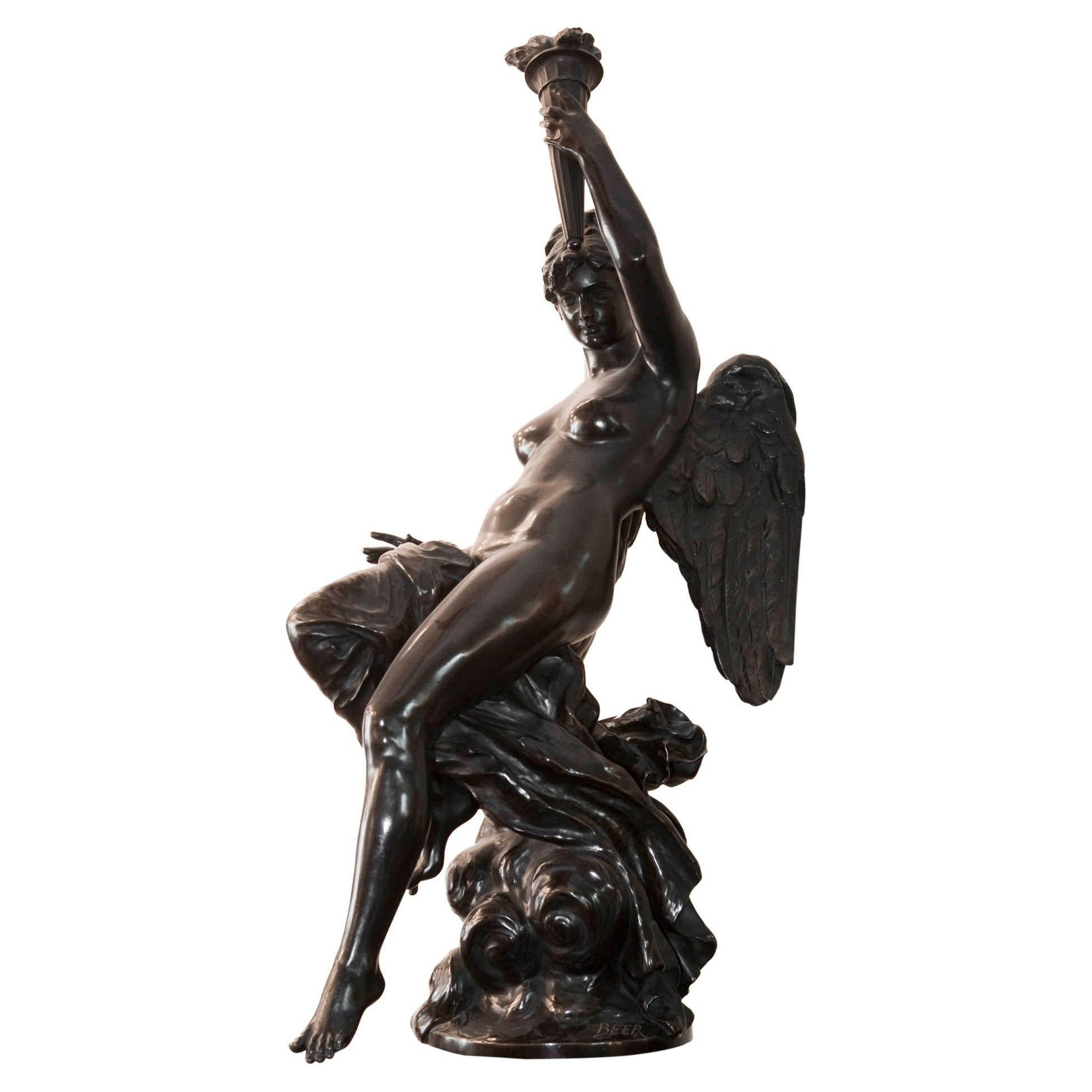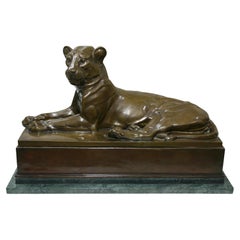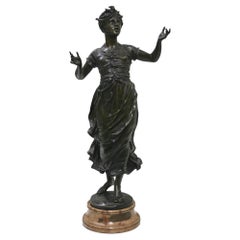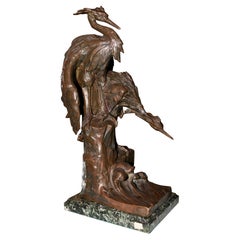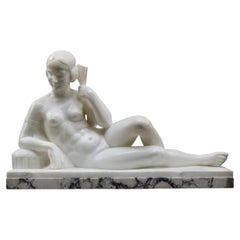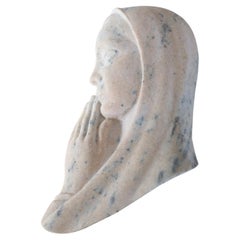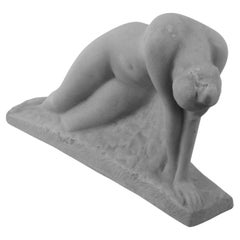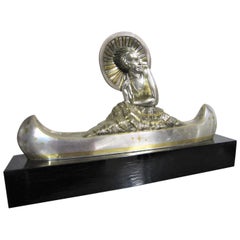Items Similar to Desing: Carlos de Lamota, Materials: Bronze and marble, Style : Art Deco
Video Loading
Want more images or videos?
Request additional images or videos from the seller
1 of 22
Desing: Carlos de Lamota, Materials: Bronze and marble, Style : Art Deco
About the Item
Design: Carlos de Lamota
He was born on August 13, 1924, in the Province of San Juan, Argentina. His passion for art began at a very early age. At 11, he attended Anita Volspranky’s workshop and later continued his studies at the Polytechnic of San Juan. In 1943, he began at the National Academy of Fine Arts at the National University of Cuyo in Mendoza. There, he was a student of renowned artists such as Delhez, Chilean artist Lorenzo Domínguez, Gómez Cornet, Sergi, and Cascarini. It was during this time that he developed a passion for the history of Egyptian and Greek sculpture, elements which he incorporated both directly and indirectly into his works. He began his sculptural work by carving marble, granite, and wood. During this time, he also assisted in the construction of the monument to José de San Martín and Bernardo O’Higgins in the city of Mendoza.
In 1949, he became an assistant to Lorenzo Domínguez in the sculpture department at the National University of Tucumán, where he worked until 1952. In that province, Carlos developed a friendship with Hungarian artist Lajos Szalay and worked with Spilimbergo. In 1966, he won the National Arts Fund Scholarship to travel to Europe and lived for some time in London. In 1969, he settled in Buenos Aires; but shortly afterward, he won the sculpture chair at the National University of Cuyo, Mendoza. He lived there for several years before returning to Buenos Aires. He received countless awards, including the First Prize at the Buenos Aires Municipal Salon in 1988, the Cuyo Salon in Mendoza in 1959, and the National Sculpture Salon in 1972. He was awarded the Grand Honor Prize at the National Salons of Santa Fe and Buenos Aires Sculpture Salon in 1988. Additionally, he was granted the KONEX Prize. Throughout his career, he held numerous solo and group exhibitions in Buenos Aires and, in 1957, represented Argentina at the IV São Paulo Biennial. He was also a member of the National Academy of Fine Arts. His works are part of important national and international collections. Carlos De la Mota passed away in Buenos Aires in 2011.
Exhibitions
Carlos de la Mota has exhibited his works in numerous museums, art galleries and art fairs, especially in Argentina. Below is a list of the main exhibitions:
1954: IV Biennale of Sao Paulo , Brazil, sculptures.
1960: Salon Internacional de Arte, Museo de Arte Moderno [ archive ] , Buenos Aires, sculptures.
1967: Galeria Rubbers [ archive ] , Buenos Aires, sculptures.
1970 and 1975: Art Gallery International, Buenos Aires, sculptures.
1970 and 1975: Salon Palanza, Buenos Aires, sculptures.
1972: Tucuman Salon, Tucuman, collective exhibition of sculptures.
1974: Teatro Municipal General San Martin , Buenos Aires, sculptures.
1975: Salon de Escultura Argentina, Fundacion Lorenzutti, Buenos Aires, sculptures.
1976: Galeria Bonino, Buenos Aires, sculptures and paintings.
1977: Galeria Palatina [ archive ] , Buenos Aires, exhibition of sculptures and tapestries with Rosalia Briones Ruiz.
1981: Galeria Palatina, Buenos Aires, sculptures.
1982: Museo Municipal de Arte Moderno, Mendoza, sculptures.
1984: Galeria Palatina, Buenos Aires, sculptures and drawings.
1988: Centro Cultural Recoleta [ archive ] , Buenos Aires, retrospective exhibition of sculpture.
1990: Museo Municipal de Bellas Artes [ archive ] , La Plata , sculptures.
1993: Galeria Palatina, Buenos Aires, sculptures and pastels.
1997: Galeria Palatina, Buenos Aires, sculptures, drawings, pastels and tapestry by Rosalia Briones Ruiz.
1997: Museo Municipal de Escultura Luis Perloti [ archive ] , sculptures.
1999: Galeria Lo Scarabeo, Buenos Aires, oil paintings and pastels.
2003: Museo Municipal Eduardo Sivori [ archive ] , Buenos Aires, paintings and sculptures.
2004: Galeria Centoira [ archive ] , Buenos Aires, paintings.
2005: Fundacion Alon para las Artes [ archive ] , Buenos Aires, pastels, paintings, wood assemblages.
2009: Museo del Tigre [ archive ] , sculptures, paintings and drawings.
Price
Among the prizes obtained, we can mention the following:
1962: 1st Prize at the Cordoba Salon, Argentina.
1968: Santa Fé ICLAR National Prize, Argentina.
1968: National Prize of the Province of Santa Fe, from the Institute for the Promotion of Sciences, Letters and Arts.
1971: Grand Prix Salon Cinzano, Mendoza, Argentina.
1972: 1st Prize for Sculpture at the Tucuman Exhibition.
1972: 1st Prize for Sculpture at the National Exhibition, Argentina.
1982 Konex Prize Diploma of Merit - Figurative Sculpture
1988: “Gran Premio de Honor” of the National Salon, Argentina.
1998: Prize of the Municipal Salon of Visual Arts, Museo Eduardo Sivori, Buenos Aires, Argentina.
Price
Among the prizes obtained, we can mention the following:
1962: 1st Prize at the Cordoba Salon, Argentina.
1968: Santa Fé ICLAR National Prize, Argentina.
1968: National Prize of the Province of Santa Fe, from the Institute for the Promotion of Sciences, Letters and Arts.
1971: Grand Prix Salon Cinzano, Mendoza, Argentina.
1972: 1st Prize for Sculpture at the Tucuman Exhibition.
1972: 1st Prize for Sculpture at the National Exhibition, Argentina.
1982 Konex Prize Diploma of Merit - Figurative Sculpture
1988: “Gran Premio de Honor” of the National Salon, Argentina.
1998: Prize of the Municipal Salon of Visual Arts, Museo Eduardo Sivori, Buenos Aires, Argentina.
We have specialized in the sale of Art Deco and Art Nouveau and Vintage styles since 1982. If you have any questions we are at your disposal.
Pushing the button that reads 'View All From Seller'. And you can see more objects to the style for sale.
Why are there so many antiques in Argentina?
In the 1880 – 1940 there was a grate wave of immigration encouraged by the periods of war that were taking place.
1st World War took place between 1914 and 1918
2nd World War took place between 1939 and 1945
The immigrants options were New York or Buenos Aires. Tickets were cheap and in Buenos Aires they were welcomed with open arms, as it was a country where everything was still to be done.
Argentina was the country of new opportunities, labour was needed and religious freedom was assured, in many cases the of the family travel first until they were settled and then the rest of the family members join them.
In the immigrant museum “Ellis Island Immigrant Building” in New York you can se the promotional posters of the boats that would take them to a new life.
Between the years 1895 and 1896, Argentina had the highest DGP (gross domestic product) per capita in the world according to the Maddison Historical Statistics index, this situation arose due to the large amount of food being exported to European countries, which were at war.
The Argentinean ships left the port of Buenos Aires with food, but they returned with furniture, clothes and construction elements, (it´s common to see this the old buildings of the historic neighbourhood of San Telmo, the beams with the inscription “Made in England)”, as well as many markets that were built in Buenos Aires, such us the San Telmo Market, whose structure was brought by ship and afterwards assembled in 900 Defensa Street.
With the great influence of European immigrants living in the country, the children of the upper classes travelled to study in France, resulting in the inauguration of “La Maison Argentinienne”, on 27th of June 1928, in the international city of Paris, which hosted many Argentinians that were studying in Frace.
It´s the fourth house to be built after France, Canada and Belgium, being the first Spanish-speaking one. Still in place today (17 Bd Jourdan, 75014, Paris, France). Many of the children of these wealthy families who attended international art exhibitions, museums and art courses abroad, took a keen interest in the European style. This is why Buenos Aires was at the time referred as “The Paris of South America”.
Between the years 1890 and 1920 more than a hundred Palaces were built on Alvear Avenue the most exclusive avenue in Buenos Aires. Today some of these palaces have been transformed into museums, hotels and embassies.
In the year 1936, the Kavanagh building was inaugurated, it was the tallest reinforced concrete building in South America.
During 1994 the American Society of Civil Engineers distinguished it as an “international engineering milestone”, and it´s now considered a World Heritage of Modern Architecture.
At the time was common to hire foreign architects such as Le Corbusier, who visited Buenos Aires/Argentina in 1929 and in 1948 he drew up the blueprints for a house built in La Plata City (which was declared a World Heritage Site).
In 1947, the Hungarian architect Marcelo Breuer designed “Parador Ariston” in the seaside city of Mar del Plata. After an Argentinean student at Harvard University convinced him to come to Argentina. He worked on an urban development project in the Casa Amarilla, area of La Boca.
The Ukrainian architect, Vladimiro Acosta, arrives in Argentina in 1928 and worked as an architect until que moved to Brazil.
Antonio Bonet, a Spanish architect who worked with Le Corbusier in Paris, arrives in Argentina in 1937, where he carried out several architectural works and in 1938 designs the well-known BFK chair.
Andres Kálnay, of Hungarian origin, made around 120 architectural masterpieces, among which the former Munich brewery stands out, he even made the furniture’s design.
The German architect, Walter Gropius, director of the Bauhaus, lived in Argentina, where he wrote articles for “Sur” magazine and founded in Buenos Aires, an architectural firm with Franz Möller, who was also an architect, where he built two houses.
At the same time several famous designers decided to immigrate to Argentina, among them we can find the well-known French designer, Jean-Michel Frank, who arrived in the country in 1940 and also worked for the Rockefeller family.
Special pieces were made, which were sold exclusively in the country, such as the well-known German company “WMF”, who sold their products by catalogue, which were chosen by the ladies of high society in the list of wedding gifts, as well as the pieces designed by Christofle.
The Swiss sculptor Alberto Giacometti, made special pieces for Argentinean mansions.
In 1904 the first Jansen branch outside Paris was established in Buenos Aires, as the Argentinean clientele demanded a large amount of furniture, from the end of the 19th century to the mid-20th century.
In 1970, the brand Rigolleau Argentina made pieces authorised by Lalique.
The brands Maple and Thompson also set up shop in the country.
The French plastic artist, Marcel Duchamp moved to Argentina in 1918-1919.
Glass signed Gallé, Charder, Leverre, Schneider, Muller and other French firms. They were bought in flower shops and were given to ladies with beautiful floral arrangements.
Some furniture manufacturers travelled to international fairs and bough the patterns to produce the furniture in Argentina, such as the furniture firm Englander and Bonta, who bought the patterns ins Italy.
It is worth mentioning that in Argentina we have the largest community of Italians outside of Italy, as it is estimated that 70 percent of the inhabitants have at least one Italian descendant, followed by Spanish immigrants.
The most Important furniture stores in Argentina:
Comte is founded in 1934 (under the direct management of Jean Michel Frank in 1940).
Nordiska (Swedish company established in 1934).
Churba in 1960, a company that brought foreign designers to present their furniture in the country:
Denmark: (Arne Jacobsen, Finn Juhl, Bender Madsen, Ejner Larsen, Poul Kjaerholm, Hans Wegner)
Sweden: (Hans Agne Jakobsson, Gustavsberg)
United States: (Herman Miller)
Finland: (Lisa Johansson, Folke Arstrom, Tapio Wirkkala, Alvar Aalto, Timo Sarpaneva)
Swedish Factory: (Orrefors)
Italy: (Littala, Vico Magistretti, Emma Gismondi, Gae Aulenti, Angelo Mangiarotti, Elio Martinelli, Gianna Celada, Angelo Mangiarotti, Mario Bellini, Carlo Scarpa)
Finland: (Olivia Toikka)
Plata Lappas (Lappas Silver): a goldsmith shop founded in 1887 in Argentina by Alcibiades Lappas of Greek origin.
In 2019, in Argentina took place “the Art Deco world congress”, in which we participated as hosts invited by Geo Darder, founder of the Copperbridge – Foundation, in which prominent people from all over the world attended to learn about Art Deco in Argentina.
Argentina currently has more than 100 Art Deco buildings and another 90 Art Nouveau buildings throughout the city of Buenos Aires.
Argentina is a country that has not been involved in many wars, which is why it has been a refuge for works of art and antiques from different periods of time, unlike European countries. That is way many collectors, museums and antique dealers from all over the world visit it, you should not miss the opportunity to visit this great country.
Laura Guevara Kjuder, architect.
- Dimensions:Height: 21.66 in (55 cm)Width: 5.91 in (15 cm)Depth: 5.71 in (14.5 cm)
- Style:Mid-Century Modern (Of the Period)
- Materials and Techniques:
- Place of Origin:
- Period:
- Date of Manufacture:1975
- Condition:Wear consistent with age and use.
- Seller Location:Ciudad Autónoma Buenos Aires, AR
- Reference Number:Seller: SC-1stDibs: LU6785243432472
About the Seller
5.0
Vetted Professional Seller
Every seller passes strict standards for authenticity and reliability
Established in 1982
1stDibs seller since 2022
35 sales on 1stDibs
Typical response time: <1 hour
- ShippingRetrieving quote...Shipping from: Ciudad Autónoma Buenos Aires, Argentina
- Return Policy
Authenticity Guarantee
In the unlikely event there’s an issue with an item’s authenticity, contact us within 1 year for a full refund. DetailsMoney-Back Guarantee
If your item is not as described, is damaged in transit, or does not arrive, contact us within 7 days for a full refund. Details24-Hour Cancellation
You have a 24-hour grace period in which to reconsider your purchase, with no questions asked.Vetted Professional Sellers
Our world-class sellers must adhere to strict standards for service and quality, maintaining the integrity of our listings.Price-Match Guarantee
If you find that a seller listed the same item for a lower price elsewhere, we’ll match it.Trusted Global Delivery
Our best-in-class carrier network provides specialized shipping options worldwide, including custom delivery.More From This Seller
View AllArt Deco Lyon by R. Pauschinger, German, Material: Bronze
By Rudolf Pauschinger
Located in Ciudad Autónoma Buenos Aires, C
Art deco sculpture in Bronze
Rudolf Pauschinger
Pauschinger (1882-1957) worked as a sculptor and medalist in Stuttgart; from 1910 he wa...
Category
Vintage 1920s German Art Deco Animal Sculptures
Materials
Marble, Bronze
Woman, Austria, Material, Bronze and Marble, Sign, K. Sterrer Wiens
Located in Ciudad Autónoma Buenos Aires, C
Bronze Sculpture.
Karl Sterrer
Date of birth December 4, 1885
Birthplace Vienna
Date of death June 10, 1972
Place of death Vienna
Professional painter....
Category
Vintage 1920s Austrian Art Nouveau Animal Sculptures
Materials
Marble, Bronze
2 Crane Bird Material, Bronze and Marble Sign, Susse Freres, France, 1900
By Susse Freres
Located in Ciudad Autónoma Buenos Aires, C
Sculpture in bronze
We have specialized in the sale of Art Deco and Art Nouveau and Vintage styles since 1982. If you have any questions we are at your disposal.
Pushing the button that reads 'View All From Seller'. And you can see more objects to the style for sale.
Susse freres...
Category
Antique Early 1900s French Art Nouveau Animal Sculptures
Materials
Bronze
Child sculpture in Bronze and marble
Located in Ciudad Autónoma Buenos Aires, C
Child sculpture in bronze and marble
Category
Vintage 1920s French Art Deco Figurative Sculptures
Materials
Marble, Bronze
Liberty Sculpture in Bronze and Marble, Signed: Beer
Located in Ciudad Autónoma Buenos Aires, C
Liberty sculpture in Bronze and marble.
French-Austrian sculptor, Friedrich Solomon Beer (1846-1912)
Category
Antique Early 1900s French Art Nouveau Figurative Sculptures
Materials
Marble, Bronze
"Galata Morente" Sculpture in Bronze and Marble F. Barbedienne Fonduer
By F. Barbedienne Foundry
Located in Ciudad Autónoma Buenos Aires, C
F. Barbedienne fonduer
Ferdinand Barbedienne (6 August 1810 – 21 March 1892) was a French metalworker and manufacturer, who was well known as a bronze founder. The son of a small farmer from Calvados, he started his career as a dealer in wallpaper in Paris. In 1838 he went into partnership with Achille Collas (1795-1859), who had just invented a machine to create miniature bronze replicas of statues. Together they started a business selling miniatures of antique statues from museums all over Europe, thus democratising art and making it more accessible to households.[2] From 1843 they extended their scope by reproducing the work of living artists and also diversified by making enamelled household objects. With the outbreak of the Franco-Prussian war in 1870 the firm briefly had to switch to cannon founding owing to the shortage of metals but resumed business afterwards. Following Barbedienne's death in 1892, he was buried in the Père-Lachaise cemetery and the firm was carried on by his nephew Gustave Leblanc until 1952. Among the principal artists reproduced by the firm were Antoine Louis Barye and Auguste Rodin.
The Dying Galata (Italian: Galata morente...
Category
Antique 1870s French Classical Roman Figurative Sculptures
Materials
Bronze
You May Also Like
White marble Odalisque from the Art Deco period
Located in Paris, FR
Art Deco sculpture in white marble representing a reclining odalisque, leaning on a cushion and holding a fan. The headdress is stylized, topped by a headband in the fashion of the 1930s and holds short, curly hair. The work on the face is fine and the look is accentuated by hollowed out almond-shaped eyes. The body is sculpted in the antique style and slightly androgynous. The young woman rests on a white marble base carved in the manner of a Turkish carpet, revealing geometric and floral motifs. A second base in Breche Medici supports the whole. Work of the French school of the early twentieth century.
Base dimensions: 63cm x 22cm x 3cm (24.80 in x 8.66 in x 1.18 in)
Overall dimensions: W: 65cm, D: 22cm, H: 40cm.
Overall dimensions: W: 25,6in, D: 8,7in, H: 15,7in.
THE FIGURE OF THE ODALISQUE IN ART
Odalisques are virgin slaves of the Ottoman seraglio. They were offered to the various women of the Sultan...
Category
20th Century French Art Deco Figurative Sculptures
Materials
Marble
Art Deco Italian Sculpture in Precious Pink Marble from Portugal
Located in Casale Monferrato, IT
Refined sculpture in Portugal pink marble. Great artistic quality, not signed. Face of the virgin Mary in prayer. Work of the Art Deco period.
Category
Vintage 1920s Italian Art Deco Figurative Sculptures
Materials
Marble
Art Deco Cast Marble Stone "The Awakening" by Vincent Glinsky
Located in Douglas Manor, NY
8-102 cast marble stone sculpture designer by Vincent Glinsky in 1930s
Original sculpture done in 1930
Newly cast in Italy 1960s
Russian born/American artist 1895-1975.
Category
Vintage 1960s European Figurative Sculptures
Materials
Statuary Marble
Large French Art Deco Silver and Parcel Gilt Bronze Woman in Canoe, M.L Simard
By Marie Louise Simard
Located in New York City, NY
Marie-Louise Simard (French, 1886-1963)
A large and important original French Art Deco silver and parcel gilt bronze sculpture of a female figure holding a parasol in a canoe.
The figure wears a gilt bodice and a two-tone ruffled skirt, details typical of the Art Deco movement, while she floats effortlessly in a narrow boat...
Category
20th Century French Art Deco Figurative Sculptures
Materials
Bronze, Nickel
Large French Art Deco Parcel Gilt &Silver Bronze of a Stylized Gazelle A. Kéléty
By Alexandre Kéléty
Located in New York City, NY
A large French Art Deco bronze sculpture of a gazelle in bronze with parcel gilt and silver on fluted self base.
This rare and artistic damascened, non inlaid finish epitomizes the...
Category
Mid-20th Century French Art Deco Animal Sculptures
Materials
Bronze
Vintage Bronze Male Figure on Marble Base
Located in Bloomfield Hills, MI
For centuries, artists have been inspired by the human figure and crafted the likeness in a multitude of materials. One of the most popular and ancient of these materials is cast bro...
Category
20th Century French Figurative Sculptures
Materials
Bronze
Recently Viewed
View AllMore Ways To Browse
Wedding Invite
Argentina Poster
Buenos Aires Poster
Maison Frank
Belgium Travel Poster
Mid Century Brazil Antiques
New England Travel Poster
Christofle Flower
Sellers Belgium
Frank Thompson
Aalto 70
Christofle Antiques
Lalique Stand
Alvar Aalto 70
Jean Michel Frank Argentine
Giacometti Stand
Alvar Aalto 100
Comte Argentina
